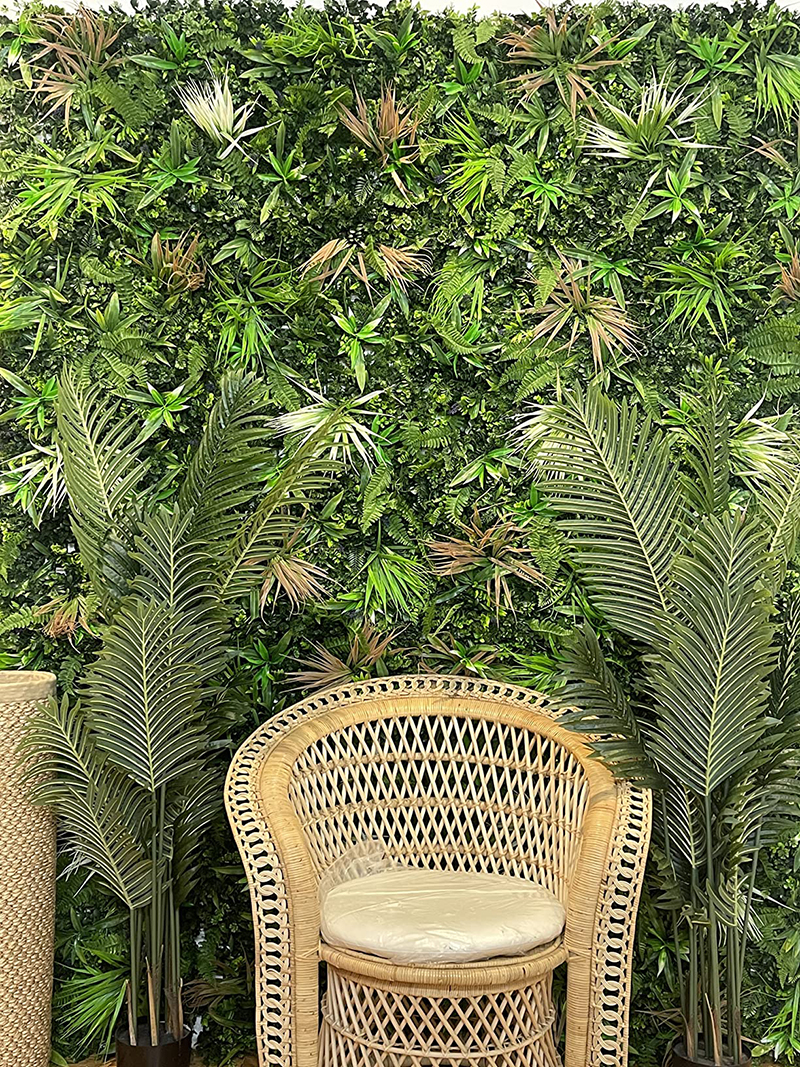Shade-Tolerant Plant Pairings for 3D Artificial Vertical Gardens: Crafting Lush Green Walls in Low-Light Environments
Artificial vertical gardens thrive in spaces where natural light is limited, such as indoor corridors, covered patios, or north-facing walls. By selecting shade-tolerant plant designs, these gardens can mimic the layered beauty of real understory ecosystems while requiring no sunlight or maintenance. Below are strategies for combining artificial plants to create vibrant, realistic green walls in low-light conditions.

Even without photosynthesis, artificial plants can replicate the textures and forms of species adapted to dim environments. This ensures a cohesive, nature-inspired aesthetic.
Fern Varieties for Soft Texture: Use artificial maidenhair ferns, Boston ferns, or bird’s nest ferns to add delicate, feathery fronds. These designs mimic the way real ferns thrive in dappled shade beneath tree canopies.
Broad-Leaved Foliage for Depth: Incorporate artificial hostas, caladiums, or begonias with large, waxy leaves. Their bold shapes create visual interest and fill gaps in vertical arrangements, resembling plants that grow in forest floors.
Spiky or Structural Accents: Introduce artificial snake plants, aspidistra, or cast iron plants to add contrast. Their upright, architectural forms break up softer textures and evoke the resilience of real shade-tolerant species.
In real forests, plants grow in overlapping layers to maximize light and space. Artificial gardens can replicate this strategy for a dynamic, three-dimensional effect.
Foreground, Midground, and Background Separation: Place shorter, more detailed plants like artificial selaginella or peperomia in the foreground. Use medium-height varieties such as ferns in the middle, and taller, bolder forms like hostas in the background. This creates an illusion of depth, even in compact vertical spaces.
Overlapping Fronds and Leaves: Allow some artificial plants to “spill” over the edges of panels or overlap with neighboring species. This mimics the way real shade plants compete for light and adds a sense of abundance.
Vertical Spacing for Airflow: Leave small gaps between plant clusters to prevent visual clutter and ensure the garden doesn’t appear overly dense. In artificial designs, these gaps also reduce dust accumulation and simplify cleaning.
Shade-tolerant plants often feature muted greens or subtle variegation. Artificial designs can draw from these natural hues to create a calming, cohesive palette.
Monochromatic Green Schemes: Stick to shades like forest green, sage, or chartreuse to evoke the look of real understory plants. This approach works well in modern or minimalist spaces where subtlety is key.
Variegation for Visual Interest: Incorporate artificial plants with white, cream, or yellow-striped leaves, such as those inspired by pothos or nerve plants. These accents add brightness without overwhelming the garden’s subdued tone.
Deep Greens for Contrast: Use artificial plants with dark, almost black-green foliage, like certain fern varieties, to create depth. Pair these with lighter-colored plants to highlight their richness.
Shade gardens often feature a mix of rough and smooth textures. Artificial designs can use this principle to add visual complexity without relying on seasonal changes.
Rough, Leathery Leaves: Combine artificial plants with thick, waxy leaves, such as those mimicking rubber plants or philodendrons, with softer, more delicate fronds. This contrast mimics the way real shade plants adapt to different microclimates.
Fine, Lacy Foliage: Introduce artificial plants with tiny, intricate leaves, like artificial selaginella or moss, to add a sense of airiness. These details work well as fillers between larger plants.
Spiky or Prickly Accents: Use artificial plants with spiny or serrated edges, such as those inspired by holly or agave, to add a rugged touch. These elements break up smoother textures and evoke the diversity of real forest floors.
By focusing on shade-tolerant plant designs, layered arrangements, muted color palettes, and textural contrast, artificial plants can transform 3D vertical gardens into lush, low-light oases. Their durability and adaptability make them ideal for spaces where natural light is scarce, ensuring year-round beauty without the need for pruning, watering, or sunlight.
Contact: Amy
Phone: 86-15311787313
E-mail: info@foszmac.com
Whatsapp:86-15311787313
Add: Fengtai District, Dacheng Road, No.24 Building, Room 203, Beijing, China